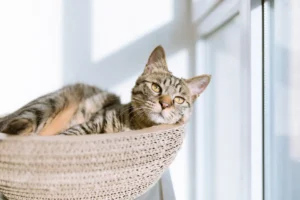National Catio Day is coming up on March 15th! Many of our feline patients have private catios or cat enclosures, and they love spending time in them. Catio comes from the words cat and patio. The idea is to provide Fluffy with a controlled area while also incorporating elements of the great outdoors. This gives your pet a safe location to engage in her favorite activities, like napping, observing birds and squirrels (and occasionally making clacking noises), lounging in the sun, meditating, and silently judging you. In this article, a local Fayetteville, NC veterinarian describes Fluffy’s purrfect private space.
What’s The Difference Between A Catio And A Kitty Enclosure?
Kitty enclosures essentially elevate the catio, taking it to the next level. These are actually set up outside the home. Fluffy will still be shielded from predators by some kind of barrier, usually mesh, chicken wire, screens, or something comparable.
This is a wonderful option for people who have somewhat adventurous pets and a place to put a kitty cage. You don’t need to make any structural changes to your property to install an enclosure for Fluffy. Many people configure them so that their feline companions can gain access through a window. You can purchase an enclosure. Or, if you’re handy, search for blueprints online and make your own.
When designing an enclosure, there are several factors to consider.
- Have fun with decorating. This location is a purrfect spot for plants and outdoor rugs!
- Make sure you incorporate some type of shade or covering.
- A catio will require flat ground and possibly a foundation. You may need to level out the area and add gravel.
- Consider a configuration that enables you to open and close Fluffy’s access door. That way, you can let her out when it’s nice outside, but keep her secure inside at night or when the weather is bad.
- Stay up to date with Fluffy’s parasite prevention! A cat enclosure will provide little or no protection against fleas, ticks, and mosquitoes.
- If you wish to use mesh fencing, choose something made of galvanized or vinyl-coated wire.
- If there are snakes in your area, you might have to take further precautions to keep them out.
Ask your Fayetteville, NC veterinarian for more information on cat enclosures.
Does Fluffy Like Catios?
Many kitties adore them! While we cannot formally survey our feline patients on this subject, we are convinced that the answer will be unanimous, or close to it.
Where Should I Put My Catio?
Anywhere you want to! A screened or enclosed porch or patio is a fantastic choice, but these are not the only alternatives. You might also use a sunroom, spare room, loft, or a sunny area.
If your patio is separate from the rest of your home, consider installing a cat door to allow Fluffy to easily access and exit her catio. You can buy doors that are synced to pets’ microchips, so they will only open for your cat. This may improve security.
Does My Kitty Actually Need A Catio?
It’s not a must, but she won’t mind! Keep in mind that you are not required to give up the space. Fluffy won’t be upset if you arrange some cozy furniture for yourself. The aim is to provide your pet with a safe environment where she may safely experience a bit of nature, preferably while enjoying a beautiful view.
What Plants Are Safe For Kitties?
No catio is complete without plants! Many ferns, like the Boston fern, Bird’s Nest fern, and Kimberly Queen fern, are safe. Spider plants, Bromeliads, Money Tree plants, Rubber Tree plants, Cast Iron plants, Rattlesnake plants, Prayer plants, and the Calathea Zebra plant are all good options as well.
If you want a pop of color, opt for orchids, African violets, hibiscuses, roses, or impatiens. If you enjoy cooking, consider using culinary herbs. Thyme, parsley, sage, rosemary, basil, valerian, witch hazel, echinacea, goldenseal, cilantro, and dill are all beneficial. Potted trees are also great options. Areca palms, Ponytail palms, and Parlor palms are all suitable. Avoid Sago palms, however, as they are toxic to both dogs and cats.
Visit the ASPCA website for additional information here.
Keep Fluffy’s safety in mind when planting. Place large, heavy pots on the floor. Don’t put things on delicate stands: your feline friend may knock or drag the plant over upon herself if she tries to eat or claw at a trailing leaf.
What Plants Should I Not Put On A Catio?
It’s equally important to understand what not to include. Lilies are at the top of the list. They are deadly to our feline friends. Even drinking the water can have serious—and potentially life-threatening—repercussions. This includes all lilies, including the Peace, Asiatic, Day, Japanese Show, Rubrum, Tiger, and Wood lilies, as well as various hybrids. While those from the real lily family are the most hazardous, all lilies should be avoided.
Other dangerous plants include tulips, daffodils, eucalyptus, Devil’s Ivy (also known as pothos, taro vine, or golden pothos), oleanders, and philodendrons. If you can’t show something is safe, proceed with caution and choose something else. Better safe than sorry!
Ask your vet for more information.
Why Make Fluffy A Catio?
A catio gives your furry friend the best of both worlds. She’ll be able to enjoy some sunlight and see birds and squirrels, while remaining safe and sound.
This is also important for enrichment and purr activation. Kitties can spend hours sunning, sleeping, and meditating. They also like spying on the local wildlife and fantasize about hunting. This can go a long way toward keeping your furry companion happy and occupied.
What Else Should I Put on a Catio?
Given the option, Fluffy would probably want wraparound cat shelves, kitty walkways, cat wheels, and a stocked fishpond. You don’t have to go that far, though. The basics would include kitty furniture, some pet-safe plants, a comfortable window seat, and possibly a scratching post. This is also an ideal spot for swimming fish toys, automatic laser pointers, and the like.
Of course, Fluffy is not going to object if you hang a bird feeder in her field of sight. This is only recommended if your cat stays indoors. Otherwise, you may be tempting the unfortunate birds to their demise!
Why Should You Keep Your Kitty Indoors?
Kitties are quite adventurous and enjoy roaming their domains. Fluffy also enjoys rolling down driveways, leaving pawprints on newly washed cars, and dropping dead animals on her humans’ doorsteps.
Unfortunately, kitties that are allowed to roam freely face some major threats. These include the weather, traffic, wild animals, parasites, pollution, and even other cats. Fluffy could also get trapped somewhere, like in a neighbor’s shed. There is also an increased risk of parasites, particularly if your feline friend hunts. Furthermore, if your cat is not spayed or neutered, she may reproduce. With pet overpopulation being such a serious issue, we encourage both spay/neuter surgery and keeping your cat indoors.
It’s also worth noting that this helps local wildlife. House cats kill billions of tiny animals each year. With so many species currently listed as threatened or endangered, we really should all do our part to help them.
Have you got any questions about your cat’s health or care? Contact us at your Fayetteville, NC animal hospital today!





